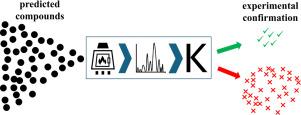求助PDF
{"title":"证明高通量粉末x射线衍射数据中预测化合物的定量标准:半反钙钛矿说明","authors":"Kyoka Nagashima, Peter Klavins, Valentin Taufour","doi":"10.1016/j.actamat.2025.121525","DOIUrl":null,"url":null,"abstract":"We introduce a simple, fast-paced analysis method for powder x-ray diffraction data to obtain a quantitative distinction between existing and likely non-existing phases. We demonstrate the method with our synthesis attempts of several previously predicted half-antiperovskites (HAPs), with stoichiometry M<span><span style=\"\"></span><span data-mathml='<math xmlns=\"http://www.w3.org/1998/Math/MathML\"><msub is=\"true\"><mrow is=\"true\" /><mrow is=\"true\"><mn is=\"true\">3</mn></mrow></msub></math>' role=\"presentation\" style=\"font-size: 90%; display: inline-block; position: relative;\" tabindex=\"0\"><svg aria-hidden=\"true\" focusable=\"false\" height=\"1.509ex\" role=\"img\" style=\"vertical-align: -0.582ex;\" viewbox=\"0 -399.4 453.9 649.8\" width=\"1.054ex\" xmlns:xlink=\"http://www.w3.org/1999/xlink\"><g fill=\"currentColor\" stroke=\"currentColor\" stroke-width=\"0\" transform=\"matrix(1 0 0 -1 0 0)\"><g is=\"true\"><g is=\"true\"></g><g is=\"true\" transform=\"translate(0,-150)\"><g is=\"true\"><use transform=\"scale(0.707)\" xlink:href=\"#MJMAIN-33\"></use></g></g></g></g></svg><span role=\"presentation\"><math xmlns=\"http://www.w3.org/1998/Math/MathML\"><msub is=\"true\"><mrow is=\"true\"></mrow><mrow is=\"true\"><mn is=\"true\">3</mn></mrow></msub></math></span></span><script type=\"math/mml\"><math><msub is=\"true\"><mrow is=\"true\"></mrow><mrow is=\"true\"><mn is=\"true\">3</mn></mrow></msub></math></script></span>Z<span><span style=\"\"></span><span data-mathml='<math xmlns=\"http://www.w3.org/1998/Math/MathML\"><msub is=\"true\"><mrow is=\"true\" /><mrow is=\"true\"><mn is=\"true\">2</mn></mrow></msub></math>' role=\"presentation\" style=\"font-size: 90%; display: inline-block; position: relative;\" tabindex=\"0\"><svg aria-hidden=\"true\" focusable=\"false\" height=\"1.509ex\" role=\"img\" style=\"vertical-align: -0.582ex;\" viewbox=\"0 -399.4 453.9 649.8\" width=\"1.054ex\" xmlns:xlink=\"http://www.w3.org/1999/xlink\"><g fill=\"currentColor\" stroke=\"currentColor\" stroke-width=\"0\" transform=\"matrix(1 0 0 -1 0 0)\"><g is=\"true\"><g is=\"true\"></g><g is=\"true\" transform=\"translate(0,-150)\"><g is=\"true\"><use transform=\"scale(0.707)\" xlink:href=\"#MJMAIN-32\"></use></g></g></g></g></svg><span role=\"presentation\"><math xmlns=\"http://www.w3.org/1998/Math/MathML\"><msub is=\"true\"><mrow is=\"true\"></mrow><mrow is=\"true\"><mn is=\"true\">2</mn></mrow></msub></math></span></span><script type=\"math/mml\"><math><msub is=\"true\"><mrow is=\"true\"></mrow><mrow is=\"true\"><mn is=\"true\">2</mn></mrow></msub></math></script></span>X<span><span style=\"\"></span><span data-mathml='<math xmlns=\"http://www.w3.org/1998/Math/MathML\"><msub is=\"true\"><mrow is=\"true\" /><mrow is=\"true\"><mn is=\"true\">2</mn></mrow></msub></math>' role=\"presentation\" style=\"font-size: 90%; display: inline-block; position: relative;\" tabindex=\"0\"><svg aria-hidden=\"true\" focusable=\"false\" height=\"1.509ex\" role=\"img\" style=\"vertical-align: -0.582ex;\" viewbox=\"0 -399.4 453.9 649.8\" width=\"1.054ex\" xmlns:xlink=\"http://www.w3.org/1999/xlink\"><g fill=\"currentColor\" stroke=\"currentColor\" stroke-width=\"0\" transform=\"matrix(1 0 0 -1 0 0)\"><g is=\"true\"><g is=\"true\"></g><g is=\"true\" transform=\"translate(0,-150)\"><g is=\"true\"><use transform=\"scale(0.707)\" xlink:href=\"#MJMAIN-32\"></use></g></g></g></g></svg><span role=\"presentation\"><math xmlns=\"http://www.w3.org/1998/Math/MathML\"><msub is=\"true\"><mrow is=\"true\"></mrow><mrow is=\"true\"><mn is=\"true\">2</mn></mrow></msub></math></span></span><script type=\"math/mml\"><math><msub is=\"true\"><mrow is=\"true\"></mrow><mrow is=\"true\"><mn is=\"true\">2</mn></mrow></msub></math></script></span> (M = Cr, Mn, Fe, Co, Ni; X = elements from Li to Bi, excluding noble gases and 4f rare-earth metals; and Z = S, Se, Te). Our criterion effectively distinguishes between compounds that have been previously reported and those that, despite being predicted, remain unreported.","PeriodicalId":238,"journal":{"name":"Acta Materialia","volume":"18 1","pages":""},"PeriodicalIF":9.3000,"publicationDate":"2025-09-16","publicationTypes":"Journal Article","fieldsOfStudy":null,"isOpenAccess":false,"openAccessPdf":"","citationCount":"0","resultStr":"{\"title\":\"A quantitative criterion for evidencing predicted compounds in high-throughput powder X-ray diffraction data: Illustration with half-antiperovskite\",\"authors\":\"Kyoka Nagashima, Peter Klavins, Valentin Taufour\",\"doi\":\"10.1016/j.actamat.2025.121525\",\"DOIUrl\":null,\"url\":null,\"abstract\":\"We introduce a simple, fast-paced analysis method for powder x-ray diffraction data to obtain a quantitative distinction between existing and likely non-existing phases. We demonstrate the method with our synthesis attempts of several previously predicted half-antiperovskites (HAPs), with stoichiometry M<span><span style=\\\"\\\"></span><span data-mathml='<math xmlns=\\\"http://www.w3.org/1998/Math/MathML\\\"><msub is=\\\"true\\\"><mrow is=\\\"true\\\" /><mrow is=\\\"true\\\"><mn is=\\\"true\\\">3</mn></mrow></msub></math>' role=\\\"presentation\\\" style=\\\"font-size: 90%; display: inline-block; position: relative;\\\" tabindex=\\\"0\\\"><svg aria-hidden=\\\"true\\\" focusable=\\\"false\\\" height=\\\"1.509ex\\\" role=\\\"img\\\" style=\\\"vertical-align: -0.582ex;\\\" viewbox=\\\"0 -399.4 453.9 649.8\\\" width=\\\"1.054ex\\\" xmlns:xlink=\\\"http://www.w3.org/1999/xlink\\\"><g fill=\\\"currentColor\\\" stroke=\\\"currentColor\\\" stroke-width=\\\"0\\\" transform=\\\"matrix(1 0 0 -1 0 0)\\\"><g is=\\\"true\\\"><g is=\\\"true\\\"></g><g is=\\\"true\\\" transform=\\\"translate(0,-150)\\\"><g is=\\\"true\\\"><use transform=\\\"scale(0.707)\\\" xlink:href=\\\"#MJMAIN-33\\\"></use></g></g></g></g></svg><span role=\\\"presentation\\\"><math xmlns=\\\"http://www.w3.org/1998/Math/MathML\\\"><msub is=\\\"true\\\"><mrow is=\\\"true\\\"></mrow><mrow is=\\\"true\\\"><mn is=\\\"true\\\">3</mn></mrow></msub></math></span></span><script type=\\\"math/mml\\\"><math><msub is=\\\"true\\\"><mrow is=\\\"true\\\"></mrow><mrow is=\\\"true\\\"><mn is=\\\"true\\\">3</mn></mrow></msub></math></script></span>Z<span><span style=\\\"\\\"></span><span data-mathml='<math xmlns=\\\"http://www.w3.org/1998/Math/MathML\\\"><msub is=\\\"true\\\"><mrow is=\\\"true\\\" /><mrow is=\\\"true\\\"><mn is=\\\"true\\\">2</mn></mrow></msub></math>' role=\\\"presentation\\\" style=\\\"font-size: 90%; display: inline-block; position: relative;\\\" tabindex=\\\"0\\\"><svg aria-hidden=\\\"true\\\" focusable=\\\"false\\\" height=\\\"1.509ex\\\" role=\\\"img\\\" style=\\\"vertical-align: -0.582ex;\\\" viewbox=\\\"0 -399.4 453.9 649.8\\\" width=\\\"1.054ex\\\" xmlns:xlink=\\\"http://www.w3.org/1999/xlink\\\"><g fill=\\\"currentColor\\\" stroke=\\\"currentColor\\\" stroke-width=\\\"0\\\" transform=\\\"matrix(1 0 0 -1 0 0)\\\"><g is=\\\"true\\\"><g is=\\\"true\\\"></g><g is=\\\"true\\\" transform=\\\"translate(0,-150)\\\"><g is=\\\"true\\\"><use transform=\\\"scale(0.707)\\\" xlink:href=\\\"#MJMAIN-32\\\"></use></g></g></g></g></svg><span role=\\\"presentation\\\"><math xmlns=\\\"http://www.w3.org/1998/Math/MathML\\\"><msub is=\\\"true\\\"><mrow is=\\\"true\\\"></mrow><mrow is=\\\"true\\\"><mn is=\\\"true\\\">2</mn></mrow></msub></math></span></span><script type=\\\"math/mml\\\"><math><msub is=\\\"true\\\"><mrow is=\\\"true\\\"></mrow><mrow is=\\\"true\\\"><mn is=\\\"true\\\">2</mn></mrow></msub></math></script></span>X<span><span style=\\\"\\\"></span><span data-mathml='<math xmlns=\\\"http://www.w3.org/1998/Math/MathML\\\"><msub is=\\\"true\\\"><mrow is=\\\"true\\\" /><mrow is=\\\"true\\\"><mn is=\\\"true\\\">2</mn></mrow></msub></math>' role=\\\"presentation\\\" style=\\\"font-size: 90%; display: inline-block; position: relative;\\\" tabindex=\\\"0\\\"><svg aria-hidden=\\\"true\\\" focusable=\\\"false\\\" height=\\\"1.509ex\\\" role=\\\"img\\\" style=\\\"vertical-align: -0.582ex;\\\" viewbox=\\\"0 -399.4 453.9 649.8\\\" width=\\\"1.054ex\\\" xmlns:xlink=\\\"http://www.w3.org/1999/xlink\\\"><g fill=\\\"currentColor\\\" stroke=\\\"currentColor\\\" stroke-width=\\\"0\\\" transform=\\\"matrix(1 0 0 -1 0 0)\\\"><g is=\\\"true\\\"><g is=\\\"true\\\"></g><g is=\\\"true\\\" transform=\\\"translate(0,-150)\\\"><g is=\\\"true\\\"><use transform=\\\"scale(0.707)\\\" xlink:href=\\\"#MJMAIN-32\\\"></use></g></g></g></g></svg><span role=\\\"presentation\\\"><math xmlns=\\\"http://www.w3.org/1998/Math/MathML\\\"><msub is=\\\"true\\\"><mrow is=\\\"true\\\"></mrow><mrow is=\\\"true\\\"><mn is=\\\"true\\\">2</mn></mrow></msub></math></span></span><script type=\\\"math/mml\\\"><math><msub is=\\\"true\\\"><mrow is=\\\"true\\\"></mrow><mrow is=\\\"true\\\"><mn is=\\\"true\\\">2</mn></mrow></msub></math></script></span> (M = Cr, Mn, Fe, Co, Ni; X = elements from Li to Bi, excluding noble gases and 4f rare-earth metals; and Z = S, Se, Te). Our criterion effectively distinguishes between compounds that have been previously reported and those that, despite being predicted, remain unreported.\",\"PeriodicalId\":238,\"journal\":{\"name\":\"Acta Materialia\",\"volume\":\"18 1\",\"pages\":\"\"},\"PeriodicalIF\":9.3000,\"publicationDate\":\"2025-09-16\",\"publicationTypes\":\"Journal Article\",\"fieldsOfStudy\":null,\"isOpenAccess\":false,\"openAccessPdf\":\"\",\"citationCount\":\"0\",\"resultStr\":null,\"platform\":\"Semanticscholar\",\"paperid\":null,\"PeriodicalName\":\"Acta Materialia\",\"FirstCategoryId\":\"88\",\"ListUrlMain\":\"https://doi.org/10.1016/j.actamat.2025.121525\",\"RegionNum\":1,\"RegionCategory\":\"材料科学\",\"ArticlePicture\":[],\"TitleCN\":null,\"AbstractTextCN\":null,\"PMCID\":null,\"EPubDate\":\"\",\"PubModel\":\"\",\"JCR\":\"Q1\",\"JCRName\":\"MATERIALS SCIENCE, MULTIDISCIPLINARY\",\"Score\":null,\"Total\":0}","platform":"Semanticscholar","paperid":null,"PeriodicalName":"Acta Materialia","FirstCategoryId":"88","ListUrlMain":"https://doi.org/10.1016/j.actamat.2025.121525","RegionNum":1,"RegionCategory":"材料科学","ArticlePicture":[],"TitleCN":null,"AbstractTextCN":null,"PMCID":null,"EPubDate":"","PubModel":"","JCR":"Q1","JCRName":"MATERIALS SCIENCE, MULTIDISCIPLINARY","Score":null,"Total":0}
引用次数: 0
引用
批量引用
A quantitative criterion for evidencing predicted compounds in high-throughput powder X-ray diffraction data: Illustration with half-antiperovskite
We introduce a simple, fast-paced analysis method for powder x-ray diffraction data to obtain a quantitative distinction between existing and likely non-existing phases. We demonstrate the method with our synthesis attempts of several previously predicted half-antiperovskites (HAPs), with stoichiometry M3 2 2


 求助内容:
求助内容: 应助结果提醒方式:
应助结果提醒方式:


